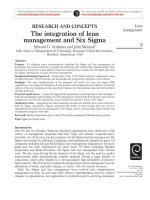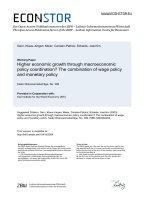The architecture of computer hardware and systems software an information technology approach suplement 3
Bạn đang xem bản rút gọn của tài liệu. Xem và tải ngay bản đầy đủ của tài liệu tại đây (771.35 KB, 40 trang )
SUPPLEMENTARY CHAPTER 3:
Communication Channel Technology
The Architecture of Computer Hardware
and Systems Software:
An Information Technology Approach
3rd Edition, Irv Englander
John Wiley and Sons
2003
Communication Channel
Supplementary Chapter 3
Communication Channel
S3-2
Communication Channels:
Many Ways to Implement
Signal: specific data transmitted
Diagram shows communication between computer
and a wireless laptop
Deceptively simple: phone line carries electrical
representation of audio signal
Physically: signal passes through different channel forms
including audio, digital, light, radio
Converters between separate physical channels
Supplementary Chapter 3
Communication Channel
S3-3
Communication Channel
Characterized by
Signaling transmission method
Bandwidth: amount of data transmitted in a
fixed amount of time
Direction(s) in which signal can flow
Noise, attenuation, and distortion
characteristics
Medium used
Supplementary Chapter 3
Communication Channel
S3-4
Signaling Transmission Method
Analog: continuous varying waveforms
to carry data
Digital:
Two different values of electrical voltage or
current or
On/off light source
Frequently preferred because less
susceptible to noise and interference
Supplementary Chapter 3
Communication Channel
S3-5
Channel Organization
Point to point channels
Simplex: channel passes data in one
direction only
Half-duplex: transmits data one direction
at a time (walkie-talkie)
Full-duplex: transmits data in both
directions simultaneously (telephone)
Multipoint: broadcasts messages to all
connected receivers
Supplementary Chapter 3
Communication Channel
S3-6
Multiplexing
Carrying multiple messages over a
channel simultaneously
TDM (time division multiplexing)
Example: packet switching on the Internet
Use: digital channels
FDM (frequency division multiplexing)
Example: Cable TV
Analog channels
Filters separate different data signals at
receiving end
Supplementary Chapter 3
Communication Channel
S3-7
Signaling Technology
Carrier waves
Electrical voltage
Electromagnetic radio wave
Switched light
Data represented by changes in the signal as
a function of time
Range of values
Analog: continuous values
Discrete: countable number of possible values
Digital: binary discrete signal
Supplementary Chapter 3
Communication Channel
S3-8
Waveform
Representation of a signal shown as a
function of time
Supplementary Chapter 3
Communication Channel
S3-9
Communicating between
Digital and Analog
Ideally conversion should be reversible
Limited by
Noise: interference from sources like radio waves, electrical
wires, and bad connections that alter the data
Attenuation: normal reduction in signal strength during
transmission caused by the transmission medium
Distortion: alteration in the data signal caused by the
communication channel
Consequences
Error correction required to compensate for transmission
limitations
Usually possible to recover original digital data exactly from
analog transmission
Small information loss results from converting analog to
digital
Supplementary Chapter 3
Communication Channel
S3-10
Analog Signals
Wireless networking
Most telephones
Satellites
Microwave communications
Radio and sound
Radio waves can be converted to electrical
signals for use with wire media for mixed
digital and analog data
Example: Cable TV with digital Internet feed
Supplementary Chapter 3
Communication Channel
S3-11
Sine Wave
Common natural occurrence
Basic unit of analog transmission
Amplitude: wave height or power
Period: amount of time to trace one
complete cycle of the wave
Frequency: cycles per second, i.e., number
of times sine wave repeated per second
f = 1/T where T is the period measured in seconds
Supplementary Chapter 3
Communication Channel
S3-12
Hertz
Measure of frequency
1 Hertz = 1 cycle/sec
Unit of bandwidth for analog device
Frequency of sine wave in diagram: 4Hz
Supplementary Chapter 3
Communication Channel
S3-13
Circle and the Sine Wave
Points on a sine wave frequently
designated in degrees
v = A sin[Θ] where A is the maximum amplitude
and Θ is the angle in the diagram
Supplementary Chapter 3
Communication Channel
S3-14
Phase
Difference,
measured in
degrees, from a
reference sine
wave
Supplementary Chapter 3
Communication Channel
S3-15
Waveform Representation
All can be represented as the sum of sine
waves of different frequencies, phases, and
amplitudes
Spectrum: frequencies that make up a signal
Bandwidth: range of frequencies passed by
the channel with a small amount of
attenuation
Filtering: controlling the channel bandwidth to
prevent interference from other signals
Supplementary Chapter 3
Communication Channel
S3-16
Signal Frequencies
Sound waves: approximately 20 Hz to 20 KHz
Stereo systems: 20-20,000 Hz for high fidelity
Phones: 0-4000 Hz for voice but limits speed
Electromagnetic radio waves: 60 Hz to 300 GHz
AM radio: 550 KHz to 1.6 MHz
20 KHz bandwidth centered around dial frequency of the station
FM radio: 88 MHz to 108 MHz
100 KHz bandwidth per station
TV: 54 MHz to 700 MHz
>4.5 MHz bandwidth per channel
Cellular phones: around 900 MHz
Supplementary Chapter 3
Communication Channel
S3-17
Signal Frequencies
Supplementary Chapter 3
Communication Channel
S3-18
Sine Waves as Carriers
A single pure tone consists of a sine wave
The note A is a 440-Hz sine wave
To represent the signal modulate one of the three
characteristics – amplitude, frequency, phase
Example: AM or amplitude modulated radio station at
1100 KHz modulates amplitude of the 1100 KHz sine wave
carrier
TV
Amplitude modulation for the picture
Frequency modulation of the sound
Phase modulation for the color
Demodulator or detector restores original waveform
Supplementary Chapter 3
Communication Channel
S3-19
Amplitude Modulations
Supplementary Chapter 3
Communication Channel
S3-20
Modulating Digital Signals
Two possible values: 0 and 1
3 techniques
ASK: amplitude shift keying
Represents data by holding the frequency constant while
varying the amplitude
FSK: frequency shift keying
Represents data by holding the amplitude constant while
varying the frequency
PSK: phase shift keying
Represents data by an instantaneous shift in the phase
or a switching between two signals of different phases
Supplementary Chapter 3
Communication Channel
S3-21
Modulating Digital Signals
Supplementary Chapter 3
Communication Channel
S3-22
Attenuation
Function of the nature of the transmission medium
and the physical length of the channel
More difficult to separate the signal from noise at
higher transmission speeds
Signal-to-noise ratio:
Strength of the signal in relation to power of the noise
Measure at the receiving end
Amplifiers: restore original strength of the signal
Supplementary Chapter 3
Communication Channel
S3-23
Effects of Attenuation
Channel fading and phase shifts vary with
the frequency of the signal
Example: If the signal consists of sine waves of
frequencies f1 and f2 from different parts of the
spectrum, the output of the channel will be
distorted
Supplementary Chapter 3
Communication Channel
S3-24
Synchronizing Digital Signals
Synchronizing digital signals difficult
Asynchronous transmission
Clear start and stop signals
Small number of bits, usually one byte
Use: low-speed modems
Synchronous transmission
Continuous digital signal
Use: high-speed modems and point-topoint methods
Supplementary Chapter 3
Communication Channel
S3-25









